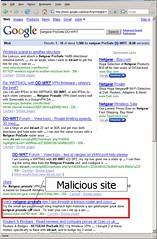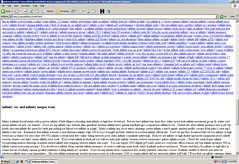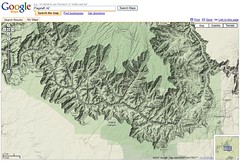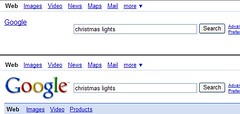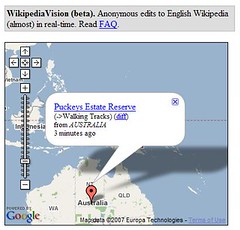Treat your Customers like Royalty and the Traffic (and Links) will Come
Have you heard the words, “reputation management” applied to SEO before? Well, if you haven’t, you certainly should. Where some corporations might argue that the blogosphere isn’t important, Zappos, the web’s biggest shoe store would, no doubt, disagree. If you have any questions about how positive the blogosphere can be for links (and traffic), grab a box of tissues and read this post entitled, “I heart Zappos.” The blogger bought a pair of women’s shoes for her mom. The post is currently ranked #12 in Google for “zappos” (and #9 in Yahoo). Want to learn how you, too can garner link love and traffic for your brand? Here are some great lessons we can learn from this story to help you manage your online reputation…
Continue reading »Possible Related Posts
Posted by stephan of stephan on 11/30/2007
Permalink | |  Print
| Trackback | Comments Off on Treat your Customers like Royalty and the Traffic (and Links) will Come | Comments RSS
Print
| Trackback | Comments Off on Treat your Customers like Royalty and the Traffic (and Links) will Come | Comments RSS
Filed under: Link Building reputation-management
Recent Google Improvements Fail To Halt Massive Malware Attack
Various news sites are reporting that a malware attack was deployed in the last couple of days, apparently based entirely upon black hat SEO tactics.
Software security company Sunbelt blogged about how the attack was generated: a network of spambots apparently added links into blog comments and forums pointing to the bad sites over a period of months in some cases, enabling those sites to achieve fair rankings in search engine result pages for a great many potential keyword search combinations. The pages either contained iframes which attempted to load malware onto visitors machines or perhaps they began redirecting to the sites containing malware at some point after achieving rankings. Sunbelt provided interesting screenshots of the SERPs in Google:
And also showed some screenshots of some of the keyword-stuffed pages which apparently got indexed:
I think it’s not at all a coincidence (more…)
Possible Related Posts
Posted by Chris of Silvery on 11/28/2007
Permalink | |  Print
| Trackback | Comments Off on Recent Google Improvements Fail To Halt Massive Malware Attack | Comments RSS
Print
| Trackback | Comments Off on Recent Google Improvements Fail To Halt Massive Malware Attack | Comments RSS
Filed under: General, Google, News, Tricks, Worst Practices black-hat-seo, blackhat-seo, Google, Malware, spam, Sunbelt
New Terrain Feature on Google Maps
The Google Operating System blog alerted us to how Google Maps quietly added a new “Terrain” button and removed the “Hybrid” button which combined Satellite and Map content. The official Google Lat Long blog reports that the “hybrid” feature can be accessed by clicking the Satellite button and the clicking on/off the “Show labels” box that appears in a dynamic drop-down.
The Terrain content can look pretty dynamic for mountain areas and other places with dramatic elevation contrasts like this area for the Grand Canyon:
I’m not sure just how valuable this is for the majority of users — (more…)
Possible Related Posts
Posted by Chris of Silvery on 11/27/2007
Permalink | |  Print
| Trackback | Comments Off on New Terrain Feature on Google Maps | Comments RSS
Print
| Trackback | Comments Off on New Terrain Feature on Google Maps | Comments RSS
Filed under: Google, Local Search, Maps Google-Maps, Maps, online-maps, Orienteering, Terrain
Google Hiding Content Behind an Image on their SERPs
Tamar Weinberg at Search Engine Roundtable reports that in a Google Groups forum, a Webmaster Central team member stated that you could use something like the z-index attribute in DHTML styles to hide text or links behind an image, so long as the text/link being hidden is what’s represented in the image.
I think it’s a good thing that they do allow this sort of use, because it appears to me that they’re doing this very thing on their own search results pages! If you refresh a search page, you can see what they’re hiding under their own logo:
…a text link pointing to their homepage.
Now, the interesting question I’d have for the Google team about this would be: this is straightforward if the image itself contains text, but what would be allowable if the image doesn’t contain text, but say, an image of a lion? There’s many different ways to express what that lion is from “lion” to “tawny, golden-furred lion king”.
Or, should we be assuming that images that are written over text and links are only allowable when the image contains text?
The Google Webmaster Tools contributor states that you could be using image’s ALT and TITLE attributes to essentially do the same thing. This is sorta funny, because one could say the same thing of Google’s use of this on their own page — why are they doing it?
One immediately wonders how Google polices this, since they’re apparently not frowning upon pages drawing images over text/links in all cases. They can detect text written over images, but would they have every instance checked by a human? Or, are they using optical character recognition algos to automatically check the text within images against the text being hidden?
In any case, the fact that Google is doing this on their own site could be taken as more confirmation that they don’t consider the technique to be bad in of itself — as long as the practice is conservative and the text/link just describes the text content within the image.
Possible Related Posts
Posted by Chris of Silvery on 11/19/2007
Permalink | |  Print
| Trackback | Comments Off on Google Hiding Content Behind an Image on their SERPs | Comments RSS
Print
| Trackback | Comments Off on Google Hiding Content Behind an Image on their SERPs | Comments RSS
Filed under: Google, Image Optimization, Search Engine Optimization, SEO Google, Search Engine Optimization, SEO, z-index, zindex
Search Engine Strategies Chicago 2007
I’ll be speaking at the upcoming Search Engine Strategies (SES) Conference in Chicago during the first week of December.
Seth Godin, author of Permission Marketing and multiple other books will be one of the keynote speakers at the conference, which is way cool — probably well worth hearing.
I’m travelling back and forth in the next few weeks, so I may only be present at the conference the same day as when I’m speaking. If you’re interested in speaking with me that day, hang around after the panel session or drop me a note in advance.
Possible Related Posts
Posted by Chris of Silvery on 11/16/2007
Permalink | |  Print
| Trackback | Comments Off on Search Engine Strategies Chicago 2007 | Comments RSS
Print
| Trackback | Comments Off on Search Engine Strategies Chicago 2007 | Comments RSS
Filed under: Conferences, Image Optimization, Seminars Conferences, Search-Engine-Strategies-Conference, ses, SES-Conference, Seth-Godin
Superpages.com Adds More User-Generated Content to the Local Mix
About a week ago, Idearc announced that Superpages.com had introduced more user-content features.
Previously, the primary component of user content on the site was limited to user ratings and reviews associated with business listings.
Some of the new features this recent upgrade added include allowing all users to enhance basic biz profile information, uploading pictures of organizations, wiki-like biz listing “blog” features which could allow simplistic blogging by businesses and/or could be used as a consumer comment or Q/A zone for each business since any user could submit info to them.
Of all the top online yellow pages and local search sites, I believe that Superpages may now have the distinction of having the greatest (more…)
Possible Related Posts
Posted by stephan of stephan on 11/14/2007
Permalink | |  Print
| Trackback | Comments Off on Superpages.com Adds More User-Generated Content to the Local Mix | Comments RSS
Print
| Trackback | Comments Off on Superpages.com Adds More User-Generated Content to the Local Mix | Comments RSS
Filed under: Design, Local Search, Market Data, News, Online Directories, Social Media Optimization, Yellow Pages idearc, Internet-Yellow-Pages, iyp, Local Search, superpages, Yellow Pages
Google Maps Now Sports Special Logo Treatment
I noticed that Google Maps started using a special logo treatment this morning:
The logo is apparently promoting Geography Awareness Week 2007.
Google has done various logos promoting holidays and other special events on the main Google logo for quite a number of years, but I believe this is one of the first ever done on one of their vertical search properties. Unfortunately, the logo doesn’t link to the special event page, and it looks a lot like a roasted turkey — the smallness of it makes it hard to read visually, so I’m betting a lot of Google Maps users won’t have a clue as to what this is signifying.
Update: the Google Lat Long blog mentions their support of Geography Awareness Week.
Possible Related Posts
Posted by Chris of Silvery on 11/13/2007
Permalink | |  Print
| Trackback | Comments Off on Google Maps Now Sports Special Logo Treatment | Comments RSS
Print
| Trackback | Comments Off on Google Maps Now Sports Special Logo Treatment | Comments RSS
Filed under: Google, Local Search, Maps, Marketing Google, Google-Maps, Logos
Google’s Advice For Web 2.0 & AJAX Development
Yesterday, Google’s Webmaster Blog gave some great advice for Web 2.0 application developers in their post titled “A Spider’s View of Web 2.0“.
In that post, they recommend providing alternative navigation options on Ajaxified sites so that the Googlebot spider can index your site’s pages and also for users who may have certain dynamic functions disabled in their browsers. They also recommend designing sites with “Progressive Enhancement” — designing a site iteratively over time by beginning with the basics first. Start out with simple HTML linking navigation and then add on Javascript/Java/Flash/AJAX structures on top of that simple HTML structure.
Before the Google Webmaster team had posted those recommendations, I’d published a little article early this week on Search Engine Land on the subject of how Web 2.0 and Map Mashup Developers neglect SEO basics. A month back, my colleague Stephan Spencer also wrote an article on how Web 2.0 is often search-engine-unfriendly and how using Progressive Enhancement can help make Web 2.0 content findable in search engines like Google, Yahoo!, and Microsoft Live Search.
Way earlier than both of us even, our colleague, P.J. Fusco wrote an article for ClickZ on How Web 2.0 Affects SEO Strategy back in May.
We’re not just recycling each other’s work in all this — we’re each independently convinced of how problematic Web 2.o site design can limit a site’s performance traffic-wise. If your pages don’t get indexed by the search engines, there’s a far lower chance of users finding your site. With just a mild amount of additional care and work, Web 2.0 developers can optimize their applications, and the benefits are clear. Wouldn’t you like to make a little extra money every month on ad revenue? Better yet, how about if an investment firm or a Google or Yahoo were to offer you millions for your cool mashup concept?!?
But, don’t just listen to all the experts at Netconcepts — Google’s confirming what we’ve been preaching for some time now.
Possible Related Posts
Posted by Chris of Silvery on 11/07/2007
Permalink | |  Print
| Trackback | Comments Off on Google’s Advice For Web 2.0 & AJAX Development | Comments RSS
Print
| Trackback | Comments Off on Google’s Advice For Web 2.0 & AJAX Development | Comments RSS
Filed under: Best Practices, Google, Search Engine Optimization, SEO AJAX, Google, Mashups, Progressive-Enhancement, Search Engine Optimization, SEO, Web-2.0
Verizon Hijacks Mistyped Domains
I was stunned today to read this report by Martin Bosworth at Consumeraffiars.com on how Verizon is delivering up custom search results pages to fiber-optic users when they misspell domain names. Since I started working from home here in the Dallas area this Spring, I’d upgraded to Verizon’s FiOS service, so this change would affect me directly. Indeed, after a moment’s worth of testing, I see that I am being sent to a Verizon search results page when I type in a domain name that doesn’t exist:
It’s not all that surprising that Verizon might do this, since they oppose net neutrality, but for users like myself, this is highly undesirable. I’ve been highly complimentary about Verizon’s FiOS service, because I’ve had excellent speed and high quality from it. I work from home providing expertise around internet technologies, so it’s vital that I be able to clearly experience the internet just as the majority of the rest of internet users out there, so having Verizon meddling with what’s delivered up to me is not cool.
If you all recall, another company did something quite similar to this back in 2003: Verisign previously did something quite similar when they abruptly launched their “Site Finder” service which (more…)
Possible Related Posts
Posted by Chris of Silvery on 11/05/2007
Permalink | |  Print
| Trackback | Comments Off on Verizon Hijacks Mistyped Domains | Comments RSS
Print
| Trackback | Comments Off on Verizon Hijacks Mistyped Domains | Comments RSS
Filed under: Domain Names, Monetization of Search, News, technology, Worst Practices Domain Names, InfoSpace, net-neutrality, VeriSign, Verizon, Yahoo
WikipediaVision Mashes Up With Google Maps and Wikipedia
An addictive little mashup called WikipediaVision has combined Google Maps with live data on updates from the English Wikipedia to display the geolocation of people editing articles in near real-time. The map rapidly pans back and forth across the world, pinpointing the locations of users who have just edited an article, and displaying the name of the article and its hyperlink.
It’s interesting and hypnotic to sit and watch where in the world (more…)
Possible Related Posts
Posted by Chris of Silvery on 11/05/2007
Permalink | |  Print
| Trackback | Comments Off on WikipediaVision Mashes Up With Google Maps and Wikipedia | Comments RSS
Print
| Trackback | Comments Off on WikipediaVision Mashes Up With Google Maps and Wikipedia | Comments RSS
Filed under: Maps, Research and Development, Tools FlickrVision, Google-Maps, Maps, Mashups, Wikipedia, WikipediaVision
